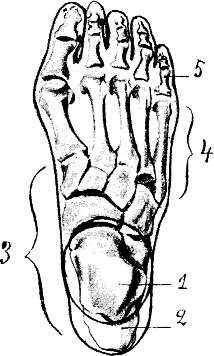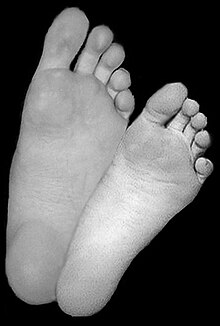Foot
The foot is a biological structure found in many animals that is used for locomotion. In many animals, the foot is a separate organ at the terminal part of the leg made up of one or more segments or bones, generally including claws or nails.
General forms
In land animals, some arthropods and all vertebrates have complex foot organs. The arthropod foot is known as a tarsus, and is distal to the tibia. In primitive insects, the tarsus was a single segment, but in more highly evolved insects the tarsus is composed of up to five segments, generally bearing claws as well.
The feet of terrestrial vertebrates, called tetrapods, first evolved in amphibians from the fins of their aquatic ancestors, fish that ventured out of the water as early as 370 million years ago, in the Upper Devonian Period, perhaps to avoid predation and exploit the greater resource availability on land. The fore- and hindlimbs of these earliest tetrapods evolved from the pectoral and pelvic fins of their fish ancestors, but early forms of feet such as those of Ichthyostega already contained the basic shape of the foot still possessed by tetrapods (although early tetrapods often had more than five digits, the most common form of foot in extant tertrapods).[1]
The feet of terrestrial vertebrates are characterized as either plantigrade, digitigrade, or unguligrade. In plantigrade animals, such as frogs, bears, and humans, the bottom of the entire foot supports the weight of the animal. In digitigrade animals, such as wolves or birds, the toes bear the animal's weight, while the upper regions of the foot, the ankle and wrist, remain elevated. Finally, in unguligrade animals, such as cows or horses, even the toes are elevated, the animal standing only atop its nails, which have evolved to bear weight and are called hooves.
Human foot
| Foot | |
|---|---|
 A human foot - Enlarge to view legend | |
| Details | |
| Artery | dorsalis pedis, medial plantar, lateral plantar |
| Nerve | medial plantar, lateral plantar, deep fibular, superficial fibular |
| Identifiers | |
| Latin | pes |
| MeSH | D005528 |
| TA98 | A01.1.00.040 |
| TA2 | 166 |
| FMA | 9664 |
| Anatomical terminology | |
Anatomy
The human foot is of the plantigrade form. The bottom of the foot is called the sole and the area just behind the toes is called the ball. The skin at the sole of the foot is denser than any other area of skin on the human body.
Bones

The major bones in the human foot are:
- Phalanges: The bones in the toes are called phalanges.
- Metatarsals: The bones in the middle of the foot are called metatarsal bones.
- Cuneiforms: There are three bones in the middle of the foot, towards the centre of the body called cuneiforms.
- Cuboid: The bone sitting adjacent to the cuneiforms on the outside of the foot is called the cuboid.
- Navicular: This bone sits behind the cuneiforms.
- Talus: Also called the ankle bone, the talus sits directly behind the navicular.
- Calcaneus: Also called the heel bone, the calcaneus sits under the talus and behind the cuboid.
The foot also contains sesamoid bones in distal portion of the first metatarsal bone.
Articulations
The articulations of the foot are:
- ankle
- intertarsal articulations
- metatarsophalangeal articulations
- interphalangeal articulations of foot
Muscles
The muscles of the foot include:
- Plantar
Arches
Culture
In different cultures across the world, feet are perceived and treated differently.
- In China, between the periods of the 10th and 20th century the practice of female foot binding was used to stop the growth of feet, resulting in an aesthetically preferred though deformed foot.
- In Middle Eastern societies, the feet are considered to be the dirtiest part of the body, on account of their constant contact with the ground. This attitude results in several Middle Eastern customs regarding the feet.
- Within several Christian denominations, foot washing is a religious ritual originating in Jesus' washing of the disciples' feet at the Last Supper.
- Foot fetishism is a sexual interest and preoccupation with feet and hosiery. Playing footsie is also a term dealing with rubbing each other's feet, and can have sexual connotations, while a foot job is a sex act involving the feet.
Customs
This article needs additional citations for verification. (August 2007) |

Customs about footwear while indoors vary significantly from place to place and usually depend on climate, weather, and other factors:
- It is customary to remove one's footwear when entering a home:
- In some cultures, bare feet may be considered unsightly or offensive. In Arab countries and in Thailand, it is considered extremely offensive to show someone the sole of your foot, although the practice of going barefoot is common, due to various reasons including hot climate and tradition.
- In many religious subgroups of Uzbekistan, touching another's foot is a sign of affection. However, more conservative families consider this to be an act of promiscuity.
- Regardless of covering, according to {{#invoke:Culture_of_Thailand|Customs|Thai norms}} feet are the least respected parts of the body; they should not be in a higher position than someone's head and should not face someone or an image of Buddha.
- The feet are one of the most common places to be tickled on the human body. The soles generally tend to be sensitive to tickling.
Customary measurement
One way to measure short distances on the ground is by placing one foot directly in front of the other; this led to the adoption of the foot as a unit of length, even though not all human feet correspond to this measure.
Myths
It is a myth that the Imperial "foot" (304.8 mm) is about the length of the average European male foot. The average today is less than 270 mm and 90% of the population is within 20 mm of that. Very few men today have feet that are a "foot" long: most are more than 35 mm shorter. In the past, the average length would have been less. Even the overall length of most shoes remains well short of one "foot". Tradition has it that the Imperial foot was based upon the size of Hercules' foot.
Medical aspects
Due to their position and function, feet are exposed to a variety of potential infections and injuries, including athlete's foot, bunions, ingrown toenails, Morton's neuroma, plantar fasciitis, plantar warts and stress fractures. In addition, there are several genetic conditions that can affect the shape and function of the feet, including a club foot or flat feet.
A doctor who specializes in the treatment of the feet practices podiatry and is called a podiatrist. A pedorthist specializes in the use and modification of footwear to treat problems related to the lower limbs.
Reflexology is an alternative therapy which involves the stimulation of the nerves and skin of the feet to improve a person's health.
Notes
- ^ Klenerman and Wood, Human Foot, 1-4
References
- Klenerman, Leslie, and Wood, Bernard. The Human Foot: A Companion to Clinical Studies. 2006, Springer. ISBN 185233925X.
External links
/\/\/\/\/\/\/\/\/\/\/\/\/\/\/\
